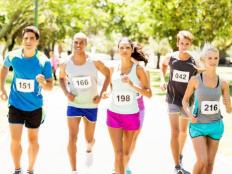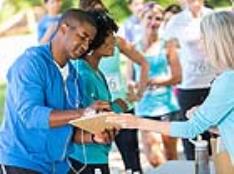Complete most of your 5K race-pace workouts on the track when your goal is to run a 5K PR. Why? The precision you get on a track is much better than using your GPS and running on a path or road. Remember, you're trying to run just 4 to 5 seconds per mile faster to get your goal PR, and you don't want to take the chance that your GSP is off by five seconds per mile.
For people who dislike the track: There is a mental aspect to running on a track that I think is important—akin to eating your vegetables. Even if you don't like something, it doesn't mean that it's not good for you. Well-rounded runners use the track to reach their potentials because it allows them to be precise with their pacing (in addition to being in a controlled environment, where you don't have to worry about traffic, bicycles, etc.)
More: Your Guide to Track Workouts
You'll want to run these track workouts in the shoes that you plan on racing in—this is the time to break in new racing shoes, as you don't want to run a race in brand new shoes.
Examples of 5K Race-Pace Workouts
A very simple 5K workout is 10 x 500m with a 100m float. The workout adds up to to 5K (5,000m) and it teaches your neuromuscular system what goal pace feels like. You want to groove the pace in this workout, not running the 500s any faster than goal pace. It takes a little bit of math to figure out what your pace should be for the 500, so you can just run the 400m at goal pace and continue to the 500-meter mark, making sure not to decelerate. The float part of this workout is the key. When you first do this workout, you run the 500m at goal pace, then you float at a pace that is faster than a jog, yet still allows you to recover, and then you go into the next 500m repeat.
When you do this workout two or three weeks later, you shouldn't run any faster on the 500s since you're trying to groove at that goal pace, but you can make the workout more challenging by pushing the pace on the float portions. Basically, you're running the same goal pace but with less rest, which is a great stimulus. This gives you a workout that is 5,900m of solid running, and it prepares you to run a solid 5K.
More: How Do I Get Faster for My Next Race?
Other solid 5K workouts:
- 12 x 400m with 30 to 60 seconds recovery, depending on your fitness
- 5 x 1,000m with a short 600m recovery jog because you get a longer workout (just over 4.5 miles)
Again, you don't need to speed up the pace of the 1,000s as your fitness improves, but you can increase your pace on the 600m recovery portion giving you a nice, long, challenging workout.
More: 3 Plans for a Faster 5K
Should You Run Faster Than 5K Goal Pace?
Finally, if you want to improve your leg speed, you need to do some work that is faster than 5K goal pace. At a minimum this means strides that are faster than 5K pace. I assign strides to my athletes the day before workouts so that the neuromuscular system is challenged just a bit, making the race-pace work the next day feel comfortable.
More: 4 Fast Tweaks to Run Like the Elites
You could do 4 x 30 seconds at faster than 5K pace with 60 to 90 seconds of slow jogging in between near the end of your easy day run. You don't need to do these on the track. The flip side is you can go to the track and run some 200s with a 200m steady jog at a pace that is a few seconds faster than goal race pace. Just five 200s the day before a 5K workout will help you feel good the next day, and will ensure that in the last 200m of the 5K race, you'll be able to kick.
If you want to run a faster 5K, keep developing your aerobic metabolism, do some race-pace work and make sure that several times a week you're doing strides faster than 5K pace.
More: 5 Reasons Your 5K Wasn't as Fast as You Hoped
 Sign up for your next 5K.
Sign up for your next 5K.- 2
- of
- 2
About the Author

Get ACTIVE on the Go


Couch to 5K®
The best way to get new runners off the couch and across the finish line of their first 5K.
Available for iOS | Android







Discuss This Article